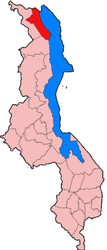Karonga
| Karonga | ||
|---|---|---|
|
|
||
| Coordinates | 9 ° 56 ′ S , 33 ° 56 ′ E | |

|
||
| Basic data | ||
| Country | Malawi | |
| Northern region | ||
| District | Karonga | |
| ISO 3166-2 | MW-KR | |
| height | 486 m | |
| surface | - | |
| Metropolitan area | 3355 km² | |
| Residents | 61,609 (2018) | |
| Metropolitan area | 194,572 | |
| density | - | |
| Metropolitan area | 58 Ew. / km² | |
Karonga is a city on Lake Malawi in northern Malawi . It has 61,609 inhabitants (2018 census) and is close to the border with Tanzania .
geography
Karonga is the capital of the district of the same name in the northern region with an area of 3355 km² and a population of 194,572 (data from 2003). There is a 1,500 meter runway, hospitals, elementary and secondary schools. There is a weekly market, several supermarkets, a post office and several banks. Karonga is on the Mzuzu - Chitipa highway . The border crossing to Tanzania, which is called Songwe Border in Malawi and Kyela Border in Tanzania, is about an hour's drive away and is closed overnight. Mbeya in Tanzania is about 115 km across the border.
Karonga is a regional seat of the state agricultural marketing agency ADMARC. The Karonga district is comparatively prosperous, as its soils are better than in the south and higher annual rainfall is recorded. Mostly cotton is grown, but also bananas, rice and corn for self-sufficiency. Karonga is now an agricultural city. It lies on a fertile plain.
For some time now, the Australian company Paladin Energy Ltd. uranium destined for export in nearby Kayelekera, on the road to Chitipa. This led to noticeable changes in the city. For example, the runway at Karonga Airport, from where the uranium is flown out directly, has increased enormously, and the number of local banks has increased from two to over five.
history
The area between Chitipa and Karonga was once the kingdom of the Ngonde , who still live here today. Then Karonga became an important base for Arab slave traders until the end of the 19th century. The most notorious among them was Mlozi, with its headquarters in Mpata . On October 27, 1887, more than 1000 Ngonde were killed in a massacre by the slave traders.
Karonga became a modern city in 1883 when the British established a trading post there and in 1895 stopped the slave trade by force of arms. A testimony from this period is an Armstrong cannon that stands in front of the city's museum. There are graves of British and German soldiers from the First World War on the road to the airfield.
Population development
The following overview shows the population by area since the 1977 census.
| year | Residents |
|---|---|
| 1977 | 11,873 |
| 1987 | 19,667 |
| 1998 | 27,811 |
| 2008 | 40,334 |
| 2018 | 61,609 |
Hominid find
In the village Uraha in Karonga the site where the oldest to lies genus Homo asked Fossils , the date of paleoanthropologists was discovered. The 2.4 million year old, dentate lower jaw was recovered in 1991 as part of the Hominid Corridor Project and was given archive number UR 501 (“UR” stands for Uraha); the fossil was assigned to the species Homo rudolfensis by its discoverers, Timothy Bromage and Friedemann Schrenk .
museum
In Karonga, a cultural and museum center, the Cultural & Museum Center Karonga (CMCK), was founded in 2004 on the basis of an initiative by Schrenk with the support of the German Society for Technical Cooperation (GTZ) and the Uraha Foundation .
There, in a large exhibition room, said important pre-human finds are exhibited and explained. There is also a fully assembled cast of the skeleton of Malawisaurus , which was also found during excavations near Karonga. In addition, evidence of the history of the settlement is shown, the origins of which range from the time of the slave trade and colonial history to the last 50 years since independence.
Due to the occurrence of stronger earthquakes in the region in December 2009, the exhibition is to be expanded with the subjects of geology and earthquakes.
Religions
In mid-2010 the Catholic Diocese of Karonga was founded, which comprises the areas that previously made up the northern deaneries of the Diocese of Mzuzu . Rt. Rev. Martin Anwel Mtumbuka was appointed first bishop.
literature
- JM Kalinga: A History of the Ngonde Kingdom of Malawi. Mouton, Berlin / New York / Amsterdam 1985, ISBN 3-11-009627-7 .
Personalities
- Chiukepo Msowoya (* 1988), football player
Individual evidence
- ↑ Malawi: Regions, Cities & Urban Places - Population Statistics, Maps, Graphics, Weather and Web Information. Retrieved January 6, 2019 .
- ↑ Communication in the Vatican of July 21, 2010 (Source: Catholic Information Service Africa, CISA, Nairobi, August 24, 2010)
